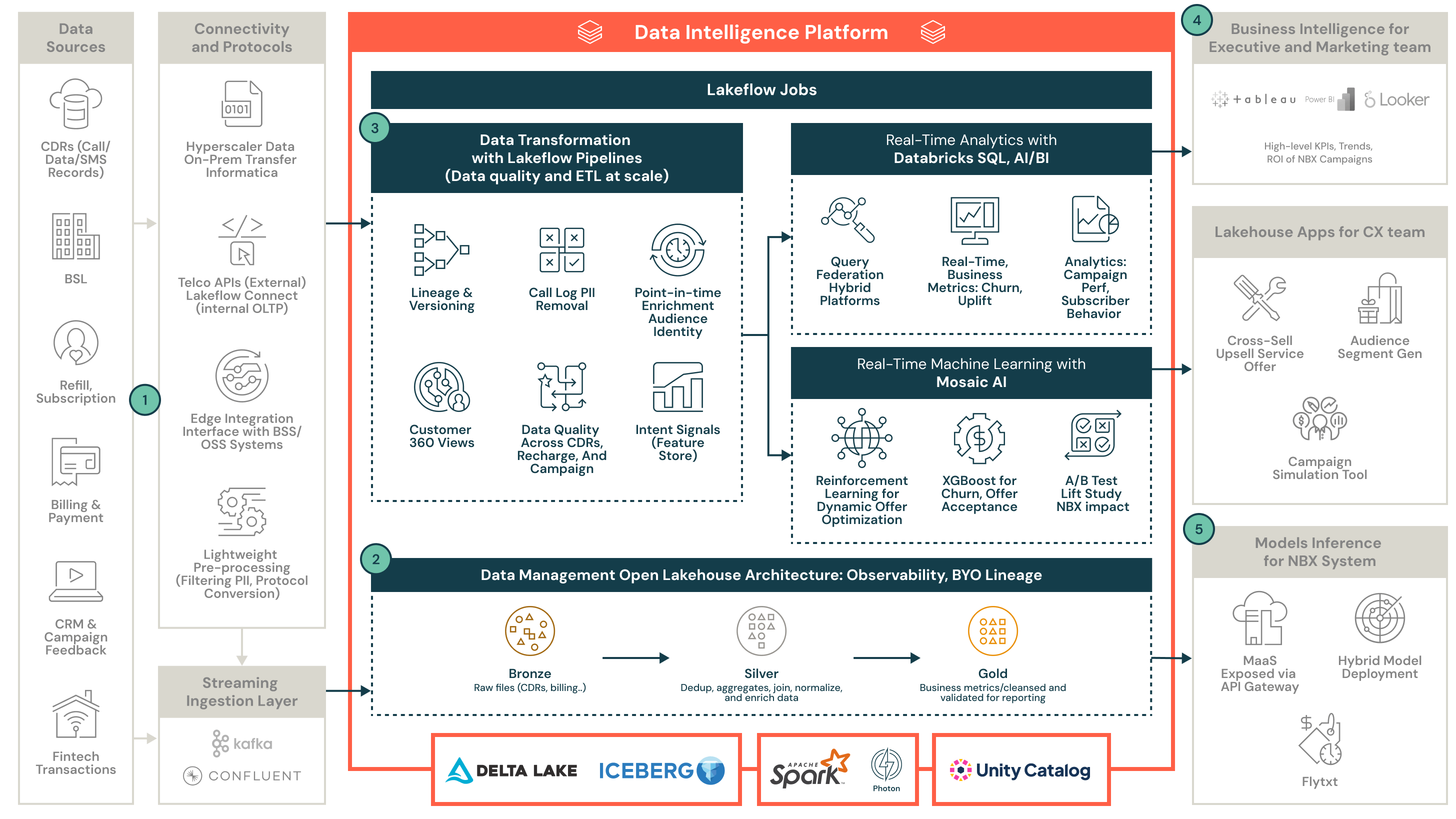Arquitetura de Referência para Ação Mais Adequada Seguinte em Telecomunicações
Esta arquitetura ajuda a entender as integrações com fontes e destinos comuns da indústria para casos de uso comuns de ação mais adequada seguinte em Telecomunicações. Ele descreve os melhores padrões de design prático em toda a arquitetura do lakehouse.

Estabeleça uma arquitetura de telecomunicações que permita a ação mais adequada seguinte em tempo real e em grande escala
Fluxos de dados e plataforma:
Ação Mais Adequada Seguinte (NBA), Melhor Experiência Seguinte (NBX)
- Ingestão de Dados dos Sistemas Operacionais de Telecomunicações
Os dados do comportamento do cliente, faturamento, CDRs (registros de chamadas/dados/SMS), CRM, recarga e transações fintech são coletados de sistemas híbridos/on-premises através de interfaces de integração BSS/OSS ou conectores de dados de terceiros como Informatica e LakeFlow. Esses fluxos de dados são enviados em tempo quase real ou em lote para a Camada de Ingestão de Streaming (por exemplo, Kafka, Azure Event Hub), onde ocorre um pré-processamento leve (por exemplo, filtragem de PII, conversão de protocolo). - Armazenamento Unificado Lakehouse e Preparação de Dados Brutos
Os dados ingeridos são armazenados em tabelas Delta Lake Bronze, particionados por atributos como OpCos, ID do site ou canal. Nesta etapa, podem ocorrer operações como aplicação de esquema e mascaramento de PII. A partir daí, os dados avançam para as tabelas Silver, onde são desduplicados, unidos e enriquecidos para construir perfis Customer 360, resumos de uso e indicadores de churn—criando uma base harmonizada e pronta para análise. - Engenharia de Recursos e Treinamento de Modelos
Os dados Silver limpos alimentam pipelines de transformação avançada usando Pipelines Lakehouse. Esta etapa inclui:- Derivando recursos de intenção e registrando-os em um Armazém de Recursos centralizado, desacoplado da lógica específica de canal ou região/país.
- Habilitando enriquecimento em tempo real e costura de identidade do público.
- Treinando modelos NBA usando Mosaic AI, incluindo casos de uso como previsão de churn, pontuação de aceitação de oferta e Aprendizado por Reforço para otimização dinâmica de oferta.
- Os modelos são treinados e gerenciados dentro da plataforma unificada com linhagem, observabilidade e governança através do Catálogo Unity.
- Um loop de feedback crítico nesta arquitetura é o teste A/B:
- Os modelos são continuamente avaliados por meio de testes de elevação em lote incorporados ao processo CICD medindo o impacto nos negócios (por exemplo, aumento, retenção, conversão).
- Essas percepções informam se os modelos atuais estão superando as linhas de base para permitir decisões objetivas sobre implantação ou re-treinamento.
- Insights de Negócios e Ativação de CX
As saídas pontuadas dos pipelines de ML são armazenadas em tabelas Gold, prontas para aplicações de BI e CX em tempo real:- Databricks SQL permite KPIs em tempo real, análise do comportamento do assinante e medição do ROI de campanhas de NBA.
- As equipes executivas e de marketing acessam esses dados por meio de ferramentas familiares como Power BI, Tableau e Looker.
- Os aplicativos Lakehouse permitem segmentação de público, simulação de campanha e direcionamento de cross-sell/up-sell para as equipes de CX.
- Implantação de Modelo e Inferência em Tempo Real
Modelos NBA treinados são expostos para ativação em tempo real através de:- APIs de Serviço de Modelo hospedadas em Mosaic AI ou Databricks Model Serving, suportando implantações híbridas.
- APIs são implantadas ou intermediadas em ambientes operacionais baseados em nuvem e/ou on-premises para integração direta com sistemas de SMS, call centers, aplicativos móveis ou IVRs.
- Os resultados da NBA são continuamente monitorados com painéis, resultados de testes A/B e rastreamento de desempenho do modelo para garantir relevância e minimizar a deriva.
Recomendado

Arquitetura das Indústrias
Arquitetura de Referência para Monitoramento de Desempenho de Rede de Telecomunicações

Arquitetura das Indústrias
Arquitetura de Referência de Gestão de Investimentos em Serviços Financeiros

Arquitetura das Indústrias
Arquitetura de Referência da Cadeia de Suprimentos Digital de Manufatura